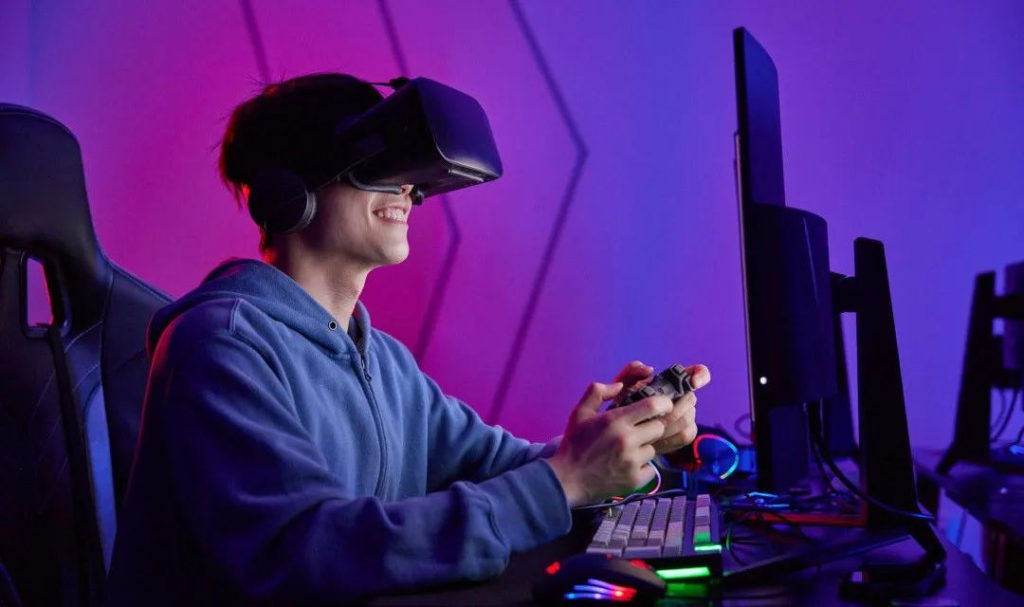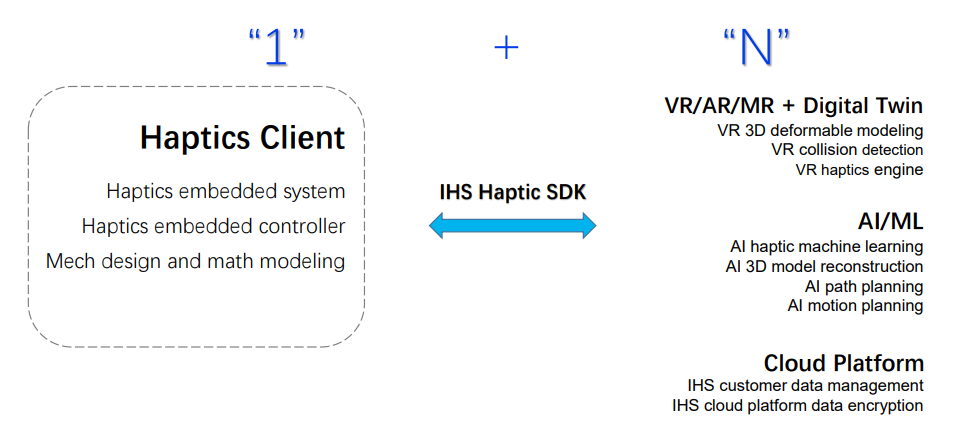
INTERLLIGENT HAPTRONIC SOLUTIONS
Interview with IHS Founder/CTO Zhouming Tang
In recent years, concepts such as AI robots, metaverse, and virtual reality have emerged and received much attention. These concepts, once unfamiliar to most people, are now gradually appearing in people’s daily production and lives, such as in mobile games and surgical training, all thanks to metaverse technology.

In the application of metaverse technology, both visual and auditory aspects have been commonly used, but haptic technology is a shortcoming. For the human body, touch is the most basic sensory function. The difficulty of haptic technology lies in the diverse dimensions of measurement. For example, when a human touches an object, the human touch will feedback sensory information such as the material, shape, and temperature of the object.

So, how can human “touch” be replicated in metaverse-related technologies? In what scenarios can haptic technology be applied in the future? Which companies have already stepped in? What is the status of their products progress and commercialization?
The First New Voice has noticed that in China there is a company specializing in robotic haptic technology and application— IHS. It owns all the intellectual property rights from hardware and software to core algorithms, and is currently committed to the development of a robot haptic technology platform applied in the medical robot field. Established for 5 years and having gone through 4 stages of polishing, the product has been mass produced and commercialized.

Recently, IHS has completed two rounds of angel+ and strategic investment, raising millions of USD. So far, the company has received 4 rounds of financing, with investors including Shanghai Laimu Electronics Co., Ltd.(603633), Shenzhen Luyou Venture Capital Co., Ltd., Shenzhen Yuanzhen Value Investment Development Co., Ltd., Shenzhen Hongxiu Venture Capital Company Limited, Hongtai Intelligent Manufacturing, and angel investor Gesheng Fei.
For this, The First New Voice conducted an interview with Zhouming Tang, the founder of IHS, and Runwei Lai, the co-founder, to decrypt the company’s growth through research on IHS‘s entrepreneurial background, development history, product model, and values. And learn about Zhouming’s vision and ideals for haptic technology from his entrepreneurial story.

Founder: Zhouming Tang

Co-founder: Runwei Lai
One. Before Entrepreneurship: Over a Decade of Theoretical Knowledge and Practical Experience
After decades of development, the field of robotics has made significant progress in computer vision and image sensors, and haptic-related technologies are also growing exponentially.
According to public data, the global haptic technology market will reach US$10 billion by 2026. At present, haptic technology has been widely used in various industry scenarios such as electronic devices, metaverse, automobile, healthcare, etc. For example, it can be seen in various game control devices, smartphones, smartwatches, and other major electronic products. The number of devices involving haptic actuators and related technologies is in the billions and is still growing significantly each year.

In the medical field, IHS has successfully achieved commercialization and developed the EndoGITrain™ Broncho-GI Pro Device. This device combines various technologies such as haptics, VR, AI, and cloud computing. It allows clinicians to efficiently conduct simulated surgery training for the digestive system. Through high-precision haptic technology, it can help them quickly master the ability of hand-eye integration and form muscle memory. The product aims to break the inefficient traditional teaching and training model and bring users systematic, precise and quantitative surgical simulation teaching training.

EndoGITrain™ Broncho-GI Pro Device
Rewinding 16 years, the haptic technology industry in the global market was not yet mature at that time and was in the scientific research stage. At that time, Zhouming was still a student.
“Because I was very interested in robots, I studied related majors from undergraduate to graduate school. My undergraduate major was electronic engineering, and my graduation project was a robot, which also gave me the opportunity to apply for graduate studies,” Zhouming recalled his experience before entrepreneurship, which can be divided into four stages.
First Stage: In September 2007, Zhouming went to the School of Engineering Sciences at Simon Fraser University to continue his studies, majoring in robotics and control engineering (SFU&UBC joint education project). During this period, he not only mastered academic knowledge, software development capabilities, and industry connections, but also gained a deeper knowledge and understanding of the commercialization and market of haptic technology, laying a theoretical foundation for future practical applications.

In September 2010, Zhouming graduated. At that time, global haptic technology was in its infancy, the commercialization model and various conditions were not yet mature. In order to gain a deeper understanding of the industry, he decided to enter the workplace for training.
“The deepest insight is that touch is divided into many subfields, and only the virtual-real interaction and VR are closely integrated. At that time, the experiments commonly conducted in major laboratories were digital scenes based on virtual digital twins on VR, but they were far from commercialization. The technology was at a very early stage, and there were no particularly well-formed VR or haptic companies on the market,” said Zhouming.
Second stage: from February 2011 to November 2017, Zhouming successively joined Teradici Corporation (Canada), a subsidiary of HP, and Microchip Corporation (USA), where he was responsible for system chip verification and design.
“At that time, I was deeply involved in the design and verification of the SOC (system-on-chip) architecture of the world’s cutting-edge cloud computing protocol system processor. The work included most of the full process of system chip design, production, and verification. During this period, I was exposed to the underlying design of the chip, firmware design, driver design, etc. between the protocol architecture and communication modules,” Zhouming explained. “In the five years until October 2016, I not only acquired the ability to develop both software and hardware, but also built a complete underlying logic and framework system for the chip. This provided me with solid practical experience for future entrepreneurship in full-stack development of both software and hardware in haptic systems.”

Third stage: after years of practical work experience, Zhouming’s entrepreneurial ideas gradually became clear in 2016 and began to take shape. He and his colleagues used their spare time to develop haptic terminals and other products, preparing for starting a business.
Between October and November of the same year, Zhouming returned from Canada to Shenzhen, China, to participate in the Overseas Returnees Entrepreneurship Conference. He successfully secured an opportunity to pitch from among more than 300 projects. Coincidentally, at this event, he first met with Runwei, who was then a partner at Shenzhen Yuanzhen Value Investment Development Co., Ltd. They added each other on WeChat and exchanged business cards.

“First of all, there were a total of 10 projects in the pitch session, and Zhouming won second place, which attracted me. Secondly, although VR/AR was quite popular globally at the time, there were no real applications; it seemed more like a bubble. However, Zhouming chose to start from the difficult point of medical surgery training, and the product combined four technologies: haptics, VR, AI, and cloud computing. Moreover, the product already had a demo prototype (which I have tried), unlike other entrepreneurs who were seeking financing with just a PPT or a bunch of concepts. Lastly, in the next six months, I found out that Zhouming likes skiing. This sport embodies the spirit of adventure, and this is exactly what entrepreneurs need to have Quality,” Runwei described his impression of Zhouming to the First New Voice.
Fourth stage: in October 2017, Zhouming raised about 1 million USD in angel round financing from Shenzhen Yuanzhen Value Investment Development Co., Ltd. and officially resigned from Microchip Technology Inc. in the United States to establish IHS.
This funding came like a timely rain, allowing the entrepreneurial seed that Zhouming had nurtured in his heart for a decade to finally sprout.
Two. Early Stages of Entrepreneurship: Clearing the Clouds to See the Moonlight
Looking back at the first few months of starting his business, Zhouming was full of confidence and enthusiasm, and had made extensive preparations.
Zhouming first decided to enter the Chinese medical market and began conducting research. For example, he visited several experts in the medical field, such as Professor Bo Jiang, the director of the Digestive Center at Tsinghua University Medical School & Beijing Tsinghua Chang Guang Hospital.
After talking with many experts and conducting research on haptic technology-related companies, he finally decided to focus on building robots for surgical teaching and training scenarios in the medical industry. Zhouming said there are three reasons:
Firstly, the initial intention of starting a business was to do something meaningful and challenging. Haptic technology must be a core technology and function in the application scenario. If you start from games or other scenarios, haptic technology is optional. However, in the field of medical training, haptics is crucial to the cultivation of muscle memory, and it is the most demanding technology among all haptic application scenarios.
Moreover, robots in medical training scenarios do not need to directly interact with the human body and do not require NMPA medical device certification. The commercialization cycle is short, and IHS achieved commercialization in just over four years. In contrast, similar surgical-assist robots need to undergo clinical trials and obtain relevant certifications such as Class III device certificates before they can be put into the market. The R&D cycle is as long as 8-10 years.
Lastly, the application of haptic technology in medical surgical training is a blue ocean market, with not many entrants and products that have not yet met market demand. “The threshold for haptic technology is quite high. For example, the mechatronic systems of haptic terminals, whether in terms of dimensions, precision, or integration with virtual reality graphics, all require complex haptic terminal support. They also cannot do without high-fidelity 3D modeling. Around 2017, there were only three or four relatively excellent haptic technology companies in the world. They have been deeply involved for more than a decade, but the bottleneck is also here. The technology is still from the previous generations. If they want to change, it’s not just the software that needs to be innovated, but also all the hardware. They have to start over again,” Zhouming analyzed.
The second is to build an organizational structure and open dual centers in Canada and Shenzhen.
“Canada is the R&D center, and Shenzhen is the production and marketing center. Experience has proven that this strategy is correct. At the end of 2018, we received scientific research funding support from the Canadian government, with about 500k USD in funding each year, and it has now accumulated to over 1.5 million USD,” Zhouming continued. The reason for setting up in China is that medical resources are relatively abundant, the efficiency of obtaining relevant data is high, and there was no regulation on the chip industry chain at the time. Therefore, a team was formed in Shenzhen. In the future, there will be more strategic layouts, such as databases and software content development, etc.
 Vancouver, Canada Office
Vancouver, Canada Office

Shenzhen, China Office
But the entrepreneurial journey is not a smooth one. In addition to the right time and place, ‘people’ are also crucial. The departure of peers put pressure on product development.
“When we started our business, the IHS team had only three people. Apart from me, one co-founder was a colleague from Canada (A), and the other was a friend in China (B), but he had his own full-time job, so he was part-time,” Zhouming joked, saying that the startup had only 2.5 people.
About two years after the company was established, both co-founders left. First, B left IHS eight months after its establishment because he wanted to focus on his own work and had no time to take care of IHS. Then A left in October 2019 due to health reasons.
Despite the setbacks, Zhouming remained optimistic, believing that haptic technology has a huge market potential. He stayed focused under extremely difficult circumstances, continued to tackle R&D challenges, and kept looking for new colleagues. In September 2018, project director Qu Deng officially joined the company. With over 10 years of experience in medical project management, he is proficient in connecting development projects with medical resources, and is familiar with the operations of the medical industry. In 2021, Runwei Lai also joined IHS as a co-founder, mainly responsible for investment and financing and government-enterprise liaison, further aiding the company’s development. In terms of software and hardware, the company continues to attract senior experts due to the interest in the advancement of scientific research on projects and trust in Zhouming himself.
With more talents joining the company, Zhouming has gained more confidence and motivation for the development of IHS. He currently plans to expand the team from 20 to over 30 people in 2023.
Three. After Four Stages of Polishing, Commercialization Was Achieved
From a startup seed to the initial success of commercialization, IHS took five years and went through four phases of refinement.
First Phase (January – October 2018): The product had a prototype architecture. The entire haptic feedback loop architecture was basically implemented, ranging from the underlying mechatronics system to the embedded system, and then to the underlying drivers, virtual and real combination, etc.

Second Phase (October 2018 – October 2019): Two main tasks were accomplished. First, the virtual interaction scene was replaced from an infeasible system to a feasible one, in the construction process of the underlying virtual reality system, the modeling of the particle grid system is combined with the virtual and real interactive graphics to complete the interaction with the hardware. Second, on the hardware side, the interaction expanded from a single handle to biopsy interaction, and a Demo prototype was produced.

VR Virtual Simulation
Biopsy Surgery Scene

IHS Virtual Simulation
Endoscope Handle/Biopsy Instruments
Third Phase (October 2019 – December 2020): On one hand, the device’s 1.0 navigation version underwent a transformation. The mechatronic system of the handle in this navigation version retained 80% similarity with the previous Demo prototype, with the remaining parts upgraded. On the other hand, mass production of the Demo prototype began.
Fourth Phase (January 2021- August 2022): The product iterated from 1.0 to 2.0. Firstly, the original handle had four dimensions of haptic feedback (forward and backward force feedback, biopsy pulling, and clamping). Later, extensions for bronchoscopy were added, and two more haptic dimensions (up and down, left and right) were added to the knob at the end of the handle. Moreover, the entire mechatronic system was optimized, including the mechanical structure and internal electronic system. Further, more endoscopic training cases were added.

IHS Gastroscopy Handle

IHS Bronchoscopy Handle
After multiple rounds of polishing, IHS’s products have finally achieved commercialization and have covered three major application fields. For example, in the field of medical surgery training, IHS has reached cooperation with more than 20 top tertiary hospitals such as Shenzhen Hospital of Southern Medical University, Beijing Tsinghua Chang Gung Hospital, and Shenzhen University General Hospital. IHS has completed the delivery of more than ten surgical training simulators, including gastroscopy, colonoscopy, and bronchoscopy three-in-one training simulators. At the same time, more than 30 products are prepared for delivery, with order amounts close to 4 million USD, and it is expected that the total orders will exceed 15 million USD in 2023.

“Currently, the medical training market is at a critical point. 5-8 years ago, this market still needed cultivation and education. Service providers had to popularize the concept of virtual simulation training to hospitals and dealers. But now they are gradually recognizing and understanding haptic technology, although the current mainstream products and functions on the market still cannot fully meet their needs,” said Zhouming.
In addition, in the automotive industry, IHS entered the Rolls-Royce innovation supplier ecosystem through a challenge competition and has signed a technical cooperation NDA with German industrial giant BOSCH. In the gaming and entertainment field, IHS has signed technical cooperation NDAs with international technology giants Microsoft, SAMSUNG, and ByteDance PICO.

It has been observed that, technical talents who start businesses often have a drawback. Either they only understand software and find it difficult to master complex electronic hardware design and human-machine interaction, resulting in products that are usually oriented towards specific hardware environments and are difficult to integrate; or they only understand hardware, and no matter how good the stacked performance is, it is difficult for users to control and has limited scene coverage. Only the deep integration of software and hardware is the correct development path for haptic technology.
In this regard, Zhouming may be the first person in China to commercialize haptic technology. The factors behind his success are multifaceted. He not only has R&D at the hardware level but also development at the software level. Most importantly, he has successfully built a leading XR platform with haptic feedback, and has successfully achieved mass production.
“From the Chinese market perspective, haptic-related startups will gradually emerge in the next 1-3 years. There are some companies in the world that make general haptic devices, such as haptic gloves, but they are expensive and have not been widely used. This is because haptic gloves require not only wearing gloves but also carrying a receiving processor, so they have not yet truly achieved commercialization. Therefore, IHS has a strong competitive advantage in China and other countries around the world, and has promising future development prospects,” said co-founder Runwei.
The reason why IHS has become a successful example of the commercialization of haptic technology is not only because the founder has an adventurous spirit and technical advantages but also because IHS has advanced commercialization models, concepts, and insights.
From the perspective of the Chinese market, IHS’s business model and technological path differ from other manufacturers. It does not follow the model of Chinese substitution but take a path of full-around innovation. Although the application scenarios are similar to other competitors, the overall solution, from the underlying mechatronics system, core algorithms, to software, is different. IHS has fully realized the self-research of core technology stacks.
Currently, Chinese companies in the field of endoscopy and dentistry are still immature in the presentation of haptic feedback functions, because they cannot independently develop a haptic system. They basically purchase third-party general haptic devices and combine them with their own. IHS has widened the gap with existing products from the underlying technology.
“Our endoscopy handle has a self-developed mechatronics system and induction system, and the shell is also made by ourselves, so the overall material cost has been reduced. You must know that the cost of a real endoscopy instrument handle is at least 13k USD or even more expensive. Because the full-stack self-developed of technology has greatly reduced the cost of our products, this has created a huge advantage for market promotion,” Zhouming said.
From the perspective of the international market, although brands such as 3D SYSTEMS from the U.S., Surgical Science from Sweden, and CAE from Canada are old players in the field, they focus only on surgical training and have not extended to other haptic scenarios.
“Their philosophy may be to sell more products and expand their market share. They have been doing this for over 20 years, and the haptic solutions they provide are still conventional. The concept of IHS is to be a cutting-edge haptic technology company, and we have not yet encountered direct competitors,” Zhouming analyzed.
Regarding the current situation and pattern of the haptic industry, co-founder Runwei believes, “The application of haptic technology is still at the sensing layer and control layer, mainly focusing on industrial soft grasping. What I care more about is how to use sensors to embody the physical form, material, scene, and force sense of objects in reality in a digital form, and to accurately simulate these external information through feedback devices to form a closed loop of virtual and real interaction. It is currently difficult to implement. From the perspective of haptic feedback and haptic interaction, most companies currently focus on linear motors and algorithms that adapt to linear motors. Currently, no company in China can do both haptic terminal devices and haptic interaction algorithms, and can also add haptic functions in the modeling process to link well with terminal actuators and open up the bottom layer. This requires very high technical requirements for the combination of software and hardware, and it is best to understand both haptics and vision. This is exactly the field that Zhouming is good at, and I believe that IHS will definitely become an excellent haptic interaction platform company in the future.”
Considering the company’s long-term development, in the next five years, IHS plans to deepen its services in the industries it has already covered and use its unique resources to expand into the international market. In addition, the company hopes to make its underlying data platform more modular and enrich in the future, and build itself into a provider of haptic technology solutions in 3 to 5 years that can be integrated with major ecosystems.